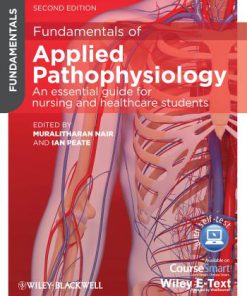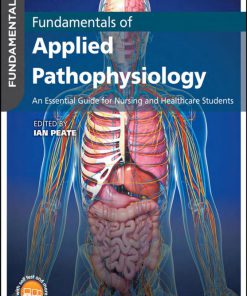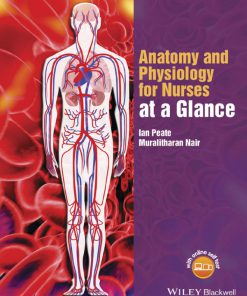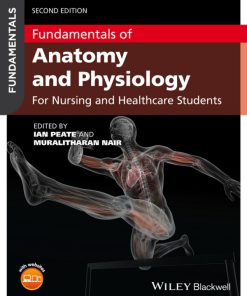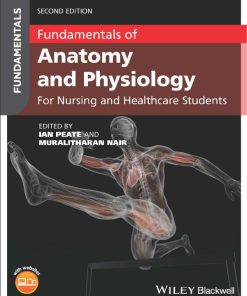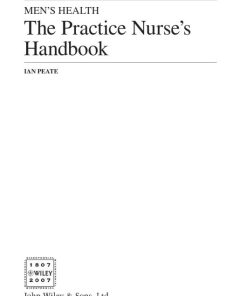Nursing Care and the Activities of Living 2nd Edition by Ian Peate 9781118302408
$50.00 Original price was: $50.00.$25.00Current price is: $25.00.
Authors:Ian Peate , Tags:ISBN-13:; 9781405194587 , Author sort:Peate, Ian , Published:Published:May 2010 , Comments:Comments:Wiley-Blackwell
Nursing Care and the Activities of Living 2nd Edition by Ian Peate – Ebook PDF Instant Download/Delivery. 9781118302408
Full download Nursing Care and the Activities of Living 2nd Edition after payment
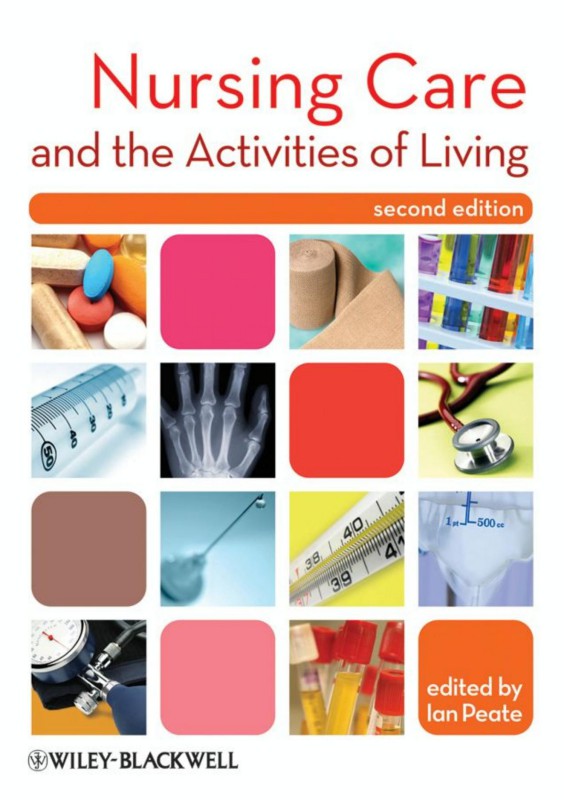
Product details:
ISBN 13: 9781118302408
Author: Ian Peate
This book gives a practical focus to the underpinning theory of nursing in order to help students through the academic part of their undergraduate course as well as their placement. The book is based on the activities of living model so each activity has its own chapter, allowing readers to dip in and out. It is essential reading for students, enabling them to understand and manage the many clinical issues they face on a daily basis when nursing adults on wards, in clinics and in the community setting.
Nursing Care and the Activities of Living 2nd Table of contents:
The Nature of Nursing
Lynn Quinlivan
Introduction
The Nursing and Midwifery Council
Registration and Professional Accountability
Standards of Conduct and Performance
Maintenance of a Register of Nurses and Midwives
Duty of Care
Fitness to Practise
Nurses and Accountability
Nursing Hierarchy
Government Directives
The Structure of the NHS in England
The Structure of the NHS in Scotland
The Structure of the NHS in Wales
The Structure of the NHS in Northern Ireland
Conclusions
References
Safeguarding Vulnerable Adults
Victoria Darby
Introduction
Defining a Vulnerable Adult and Abuse
Ethics and Safeguarding the Vulnerable Adult
Policies and Legislation for Safeguarding the Vulnerable Adult
Safeguarding Vulnerable Adults from Unprofessional Nurses
Fitness to Practise Panels
Interprofessional Collaboration
Reporting Suspicions of Abuse as a Nurse
Assessing the Seriousness of Abuse
Reporting Suspicions of Abuse as a Student Nurse
Conclusions
References
Assessing Needs and the Nursing Process
Lynda Sibson
Introduction
Models of Nursing
Activities of Living
Organisation of Nursing Care
Nursing Practice
Nursing History
Elements in Nursing
Theories, Concepts, and Models
Nursing Process
Conclusions
References
Promoting Safety
Janet G. Migliozzi
Introduction
Risk Assessment
Common Risks in Health Care
Common Factors Affecting Patient Safety
Minimising the Risk of Medication Error
Minimising the Risk of Falls
Minimising the Risk of Health Care-Associated Infection
Conclusions
References
Communicating Effectively
David Briggs
Introduction
Talking to Patients, Carers, and Colleagues Effectively and Clearly Conveying and Receiving the Intended Message
Facilitating Patients and Their Carers to Communicate Effectively
The Importance of Listening Effectively
Potential Communication Difficulties
The Differing Methods of Communication Used by Individuals
Communicating with People from Different Cultures
Coping in a Very Specific and Difficult Situation
Using Body Language Effectively
Using the Electronic Means of Distributing Information
The Ability to Know When Someone Needs to Know a Piece of Information
Information and Record Keeping
Communication and Reflective Practice
Conclusions
References
Eating and Drinking: Fluid and Nutritional Care in Practice
Jane Say
Introduction
Nutritional Issues and Clinical Practice
Obesity
Undernutrition
Disease-Related Factors
Non-Disease-Related Factors
Providing Nutritional Care in Practice
Screening/Assessment to Identify Patients’/Clients’ Nutritional Needs
Body Mass Index
Weight Loss
Recent Dietary Intakes
Stress Factors/Nature of Current Illness
Further Action, Assessment, and Referral
Planning, Implementation, and Evaluation of Nutritional Care
Monitoring and Re-Screening
Factors That Affect Nutritional Care: The Hospital and Care Environment
Assistance with Eating and Drinking
Food Provision
Nutritional Support
Improving Oral Intakes
Oral Supplements
Enteral (or Tube) Feeding
Specific Nursing Care Associated with Enteral Feeding
Parenteral Nutrition
Fluid Management in Clinical Practice
Clinical Assessment of Fluid Balance
Conclusion
References
Elimination – Alimentary and Urinary Tract
Muralitharan Nair
Introduction
The Oral Cavity
Pharynx
Oesophagus
Stomach
Small Intestine
Large Intestine
The Accessory Organs
Care of Patients with Gastrointestinal Disorders
Renal System
The Prostate Gland
Care of Patients with Urological Disorders
Conclusions
References
Breathing
Sean Mallon
Introduction
Structure and Function of the Respiratory Tract
Assessment of Respiration
Measuring Respiratory Rate, Depth, and Rhythm
Respiratory Sounds
Observation of Cough and Sputum
Other Methods of Assessing Respiratory Function
Aerosols and Nebulizers
Some Common Respiratory Diseases
Conclusions
References
Personal Cleansing and Dressing
Laureen Hemming
Introduction
Anatomy and Physiology of the Skin
Cultural Perspectives
Nursing Care
Cleansing Products
Conclusions
References
An Ergonomic Approach to Safe Manual Handling
Kim Walter
Introduction
Principles of Safe Handling and the Biomechanics of Back Injury
Ergonomics
Risk Assessment
Controversial Techniques and Hazardous Tasks
The Management of Bariatric Patients
Conclusions
References
Maintaining Body Temperature
Guy Dean
Introduction: Temperature and Metabolism
Control of Temperature
Factors Influencing Body Temperature
Body Heat Considerations
Taking the Temperature
Body Temperature
Hypothermia
Conclusions
References
Work and Leisure
Jackie Hulse
Introduction
Family Life and Gender
Employment and Inequalities
Unemployment
Health and Safety
Informal Carers
Illness and Employment
Retirement
Leisure
Conclusions
References
The Sexual Being
Ian Peate
Introduction
Policy and Key Drivers
Defining Key Terms
Assessing Sexual Health
Approaches to Assessment
Older People’s Sexuality and Health
Sexual Problems
Barriers to Sexual Discussion
Conclusions
References
Sleep and Rest
Debbie Davies
Introduction
What is Sleep?
Physiology of Sleep
The States and Stages of Sleep
Theories of the Need for Sleep
Dreaming and Sleep
Sleep Needs Over the Life Cycle
Factors Influencing Sleep
Common Primary Sleep Disorders
Promoting Sleep
Nursing Assessment
Planning Care
Implementing Care
Evaluation
Conclusions
References
Death and Dying
Mary Greeno
Introduction
Death and Dignity
Palliative Care
Where to Die
Some of the Losses a Dying Patient or the Family May Experience
Family Involvement
The Needs of the Dying Patient
Good Practice in Caring for Patients and Relatives/Friends Before Death
Signs of Approaching Death
Procedures After Death
Last Offices
Cultural and Religious Beliefs
Breaking Bad News
Conclusions
References
People also search for Nursing Care and the Activities of Living 2nd:
7 activities of daily living
6 daily activities of living
3 living things
the nursing assistant and the care team chapter 2
You may also like…
eBook PDF
Caring for Children and Families 1st Edition by Ian Peate, Lisa Whiting 0470019700 9780470019702
eBook PDF
MENS HEALTH The Practice Nurses Handbook 1st Edition by Ian Peate 0470035552 9780470035559






